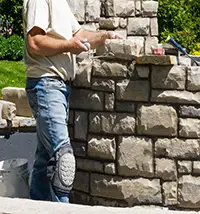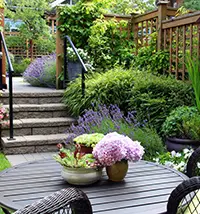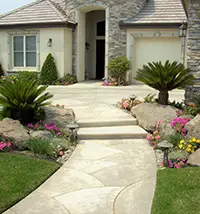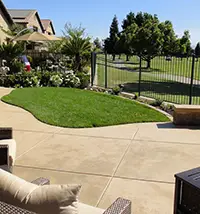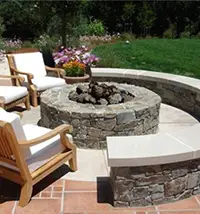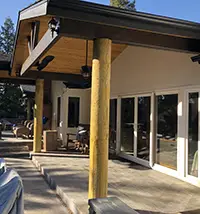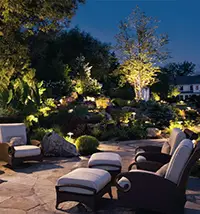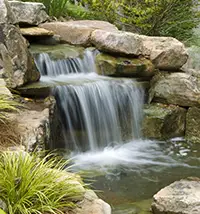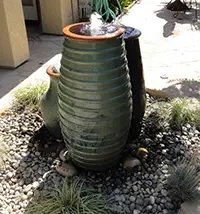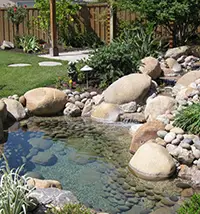Outdoor Kitchen FAQ
Ready for some answers to the most common Outdoor Kitchen FAQ (frequently asked questions)? We hope you’ll find what you need here.
However, if you don’t find the answer to your specific question here, we invite you to contact us directly. Mike’s Evergreen has been a family owned and operated landscape business serving Fresno and Clovis since 1987, and we’ve designed and installed many outdoor kitchens in that time. We’re here to help you, too.
Here are some of those most frequently asked questions about outdoor kitchens:
- What is an outdoor kitchen?
- Is an outdoor kitchen worth it?
- What are the disadvantages of an outdoor kitchen?
- Does an outdoor kitchen add home value?
- How long does an outdoor kitchen last?
- What is the ROI on outdoor kitchens?
- Do outdoor kitchens rust?
- Should I put a sink in my outdoor kitchen?
- How do I get water to my outdoor kitchen?
- How do I protect my outdoor kitchen?
- How much would it cost to build an outdoor kitchen?
- What do you do with an outdoor kitchen in the winter?
- How do you keep outside kitchen pipes from freezing?
- How close to the house can you build an outdoor kitchen?
- What should I include in my outdoor kitchen?
- How much space is needed for an outdoor kitchen?
- Can you put a dishwasher in an outdoor kitchen?
- What kind of grill do I need for an outdoor kitchen?
- Can you build an outdoor kitchen on top of pavers?
- Can you build an outdoor kitchen on a deck?

What is an outdoor kitchen?
An outdoor kitchen is an outdoor living space where you can prepare and cook food, dine, and entertain friends and family. You can customize the space to include whatever amenities you want.
For example, a full outdoor kitchen may have a grilling station, perhaps a separate cooking area and oven, and maybe an outdoor pizza oven. In addition to the cooking elements, a full outdoor kitchen is likely to include a sink, outdoor refrigerator, and possibly even an icemaker and dishwasher as well as cabinetry and counter space similar to an indoor kitchen.
A less elaborate outdoor kitchen may feature just a simple outdoor grill and a stand-alone food prep/serving area.
Most people want their outdoor kitchen design to accommodate guests, so there often is an outdoor dining area as well … sometimes at a countertop bar or at a stand-alone table. And most outdoor kitchens in the Central Valley also have some kind of overhead structure to provide shade and shelter.
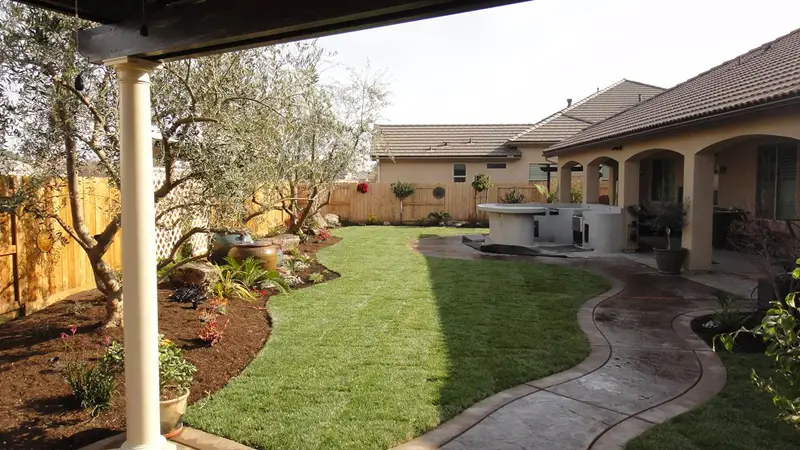
Is an outdoor kitchen worth it?
Whether an outdoor kitchen is worth it or not is up to personal preference. If you don’t enjoy being outside or outdoor entertaining, an outdoor kitchen may not be worth it to you. But if you do like being outdoors and prefer an al fresco lifestyle, then an outdoor kitchen space is most certainly worth exploring.
An outdoor cooking space can add value to your home, but perhaps even more importantly, it can add to your enjoyment of your home and help you live the lifestyle you want.
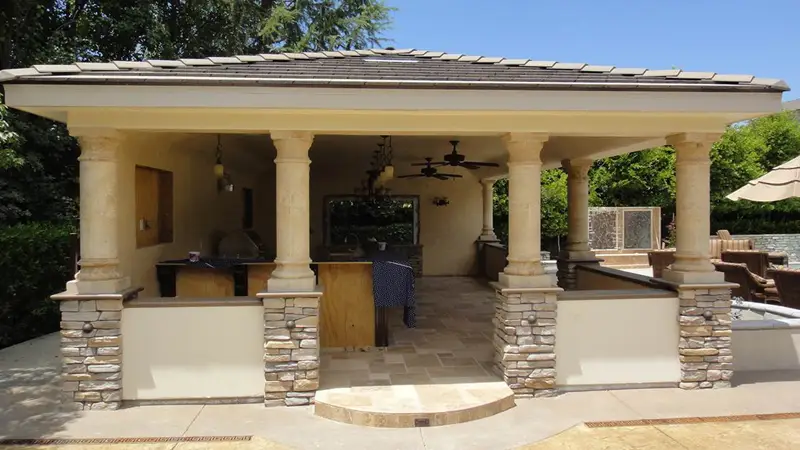
What are the disadvantages of an outdoor kitchen?
Some things you need to consider before building an outdoor kitchen are the space that it will require, getting permits and building it to code, and how to protect it against the weather.
An outdoor kitchen is generally a permanent structure that you’re adding to your property, so it’s not typically a DIY weekend project. It will take time to do it properly so that it’s both safe and will last.
Also, because it’s outside, an outdoor kitchen will have special cleaning and maintenance requirements above and beyond what’s needed indoors.
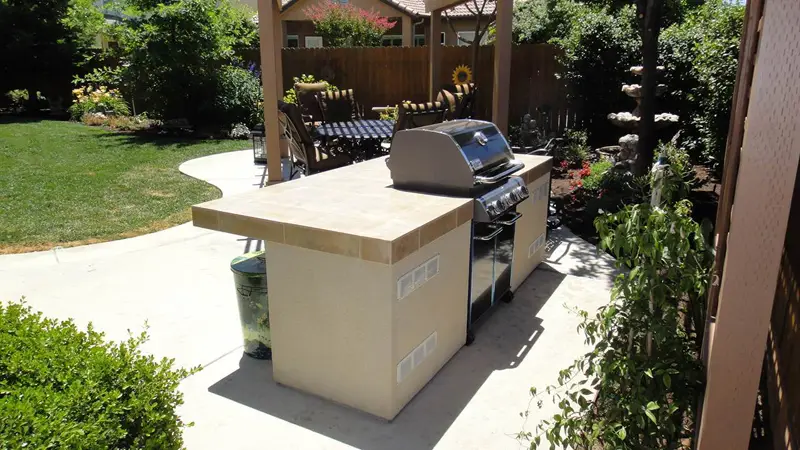
Does an outdoor kitchen add home value?
Most real estate experts agree that an outdoor kitchen adds value to your home and increases what you can sell it for. HFS Financial quotes CNN Money and Remodeling Magazine as reporting that “outdoor kitchens nationally return 100% to 200% of the improvement cost.”
But in addition to resale value, an outdoor kitchen adds immediate value to your lifestyle and enjoyment of your home.
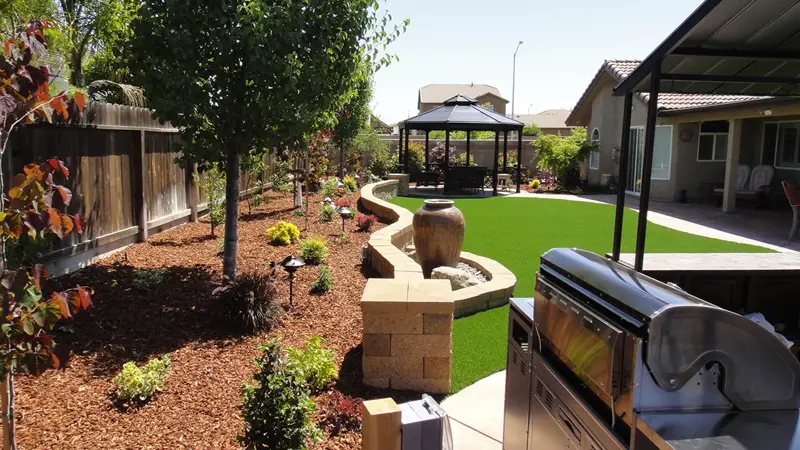
How long does an outdoor kitchen last?
The longevity of an outdoor kitchen is dependent on the quality of the materials used, the quality of the workmanship in building/installing it, and the diligence of the maintenance. If everything is done well, you can expect your outdoor kitchen to last 10 years or more. Some have lasted much longer than that.
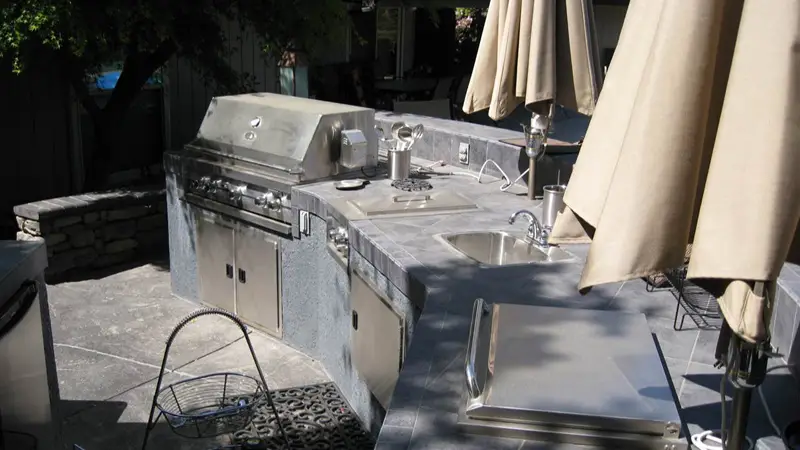
What is the ROI on outdoor kitchens?
The ROI on outdoor kitchens and outdoor entertainment spaces varies depending on the size, cost and quality of materials used, types of appliances, and even general aesthetics. With that being said, SuperMoney quotes Michael Kelczewski of Sotheby’s International Realty as saying, “the general rule of thumb is a 50% ROI for outdoor kitchens.”
While an outdoor kitchen will increase your home value, it won’t necessarily appeal to everyone. So it isn’t a project that a realtor usually suggests when getting your home ready to sell.
Rather than doing it for resale value, most homeowners have outdoor kitchens built so that they can enjoy the outdoor living space themselves. And it’s hard to put a numerical value on that.
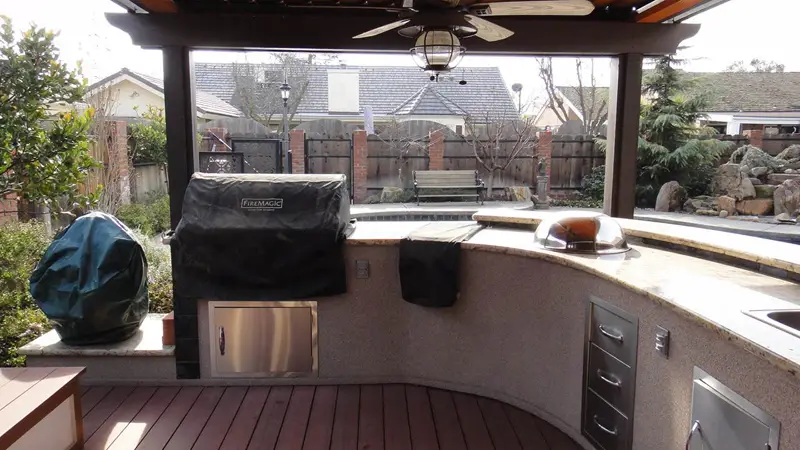
Do outdoor kitchens rust?
Certain building materials can be prone to rust when used outside where they are exposed to the weather. However, experienced outdoor kitchen builders will use materials that resist rusting.
Stainless steel, for example, is used often in outdoor spaces because it’s aesthetically pleasing and also resists rust as well as stains, corrosion, and bacteria.
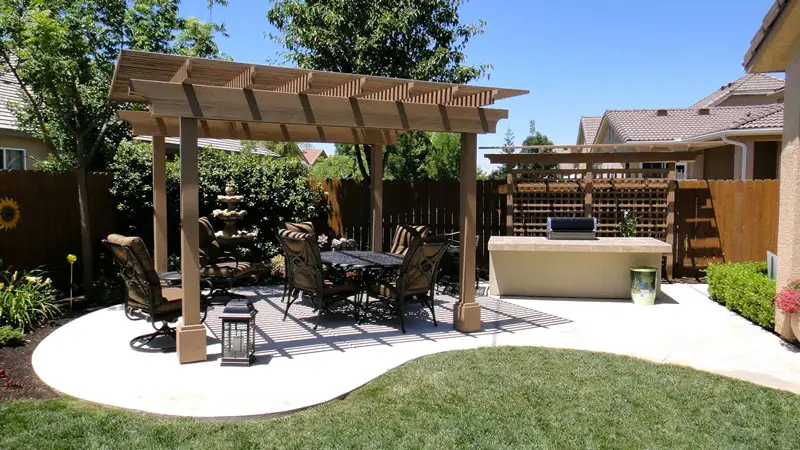
Should I put a sink in my outdoor kitchen?
Putting a sink in your outdoor kitchen is totally optional, but in most cases, it makes a lot of sense to do so.
Having a sink in your outdoor kitchen adds functionality and convenience to your space. Not only is it handy for food preparation and cleanup, but it also allows people to easily wash their hands without trekking inside to do so.
Also, homeowners who put sinks in their patio kitchens commonly find that they use these sinks at other times and for other purposes in addition to cooking meals outdoors.
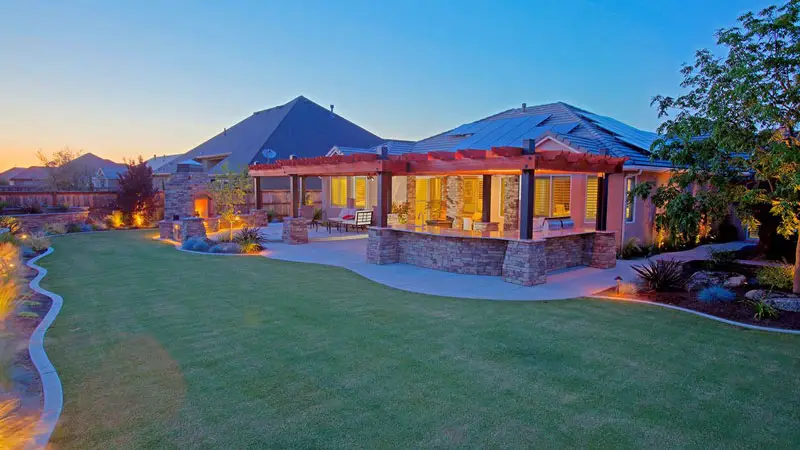
How do I get water to my outdoor kitchen?
Getting water to your outdoor kitchen is simply a matter of tying it into your home’s water lines. While simple, in theory, the process isn’t always easy and should be done only by experienced professionals.
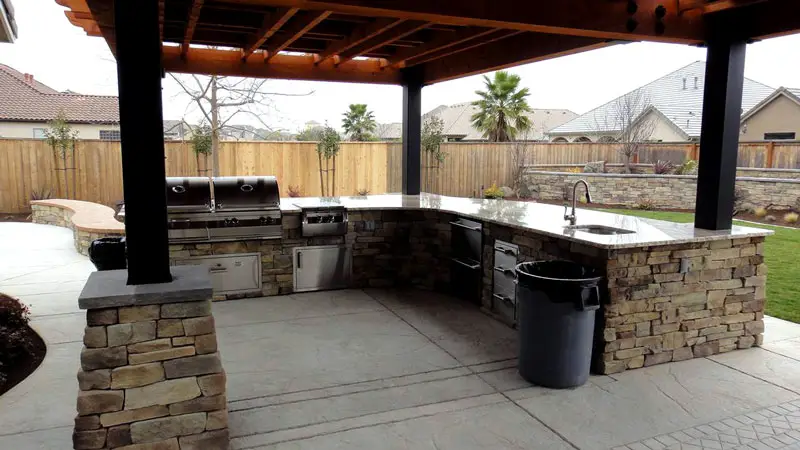
How do I protect my outdoor kitchen?
One of the best ways to protect your outdoor kitchen is to add a roof, pergola, or another type of overhead covering to protect it from the Central Valley weather. You’ll also want to seal and polish the external surfaces of your outdoor kitchen and outdoor living room (countertops, cabinets, appliances, barstools, dining table, etc.).
Just like an indoor kitchen, regular cleaning, and additional routine maintenance are required to keep your outdoor kitchen in good shape.
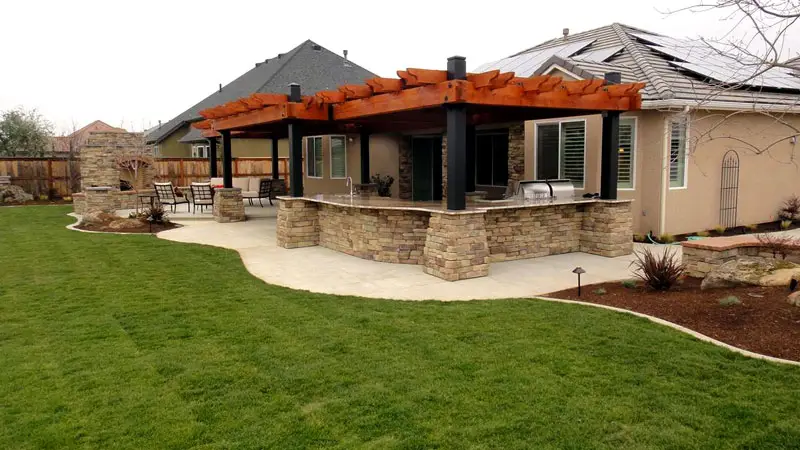
How much would it cost to build an outdoor kitchen?
The cost of an outdoor kitchen is directly related to size and what you want your outdoor kitchen to include. The major components and their average general costs, according to neutral third-party HomeLight, include:
- Flooring ($40-$100 per square foot)
- Appliances ($1,500-$7,000)
- Framing and Cabinets ($200-$600 per square foot)
- Countertops ($10-$100 per square foot)
- Overhead Covering ($25-$100 per square foot)
The best way to estimate how much it would cost to build an outdoor kitchen on your property and to meet your needs is to talk to local outdoor kitchen experts. Contact Mike’s Evergreen today to start the conversation.
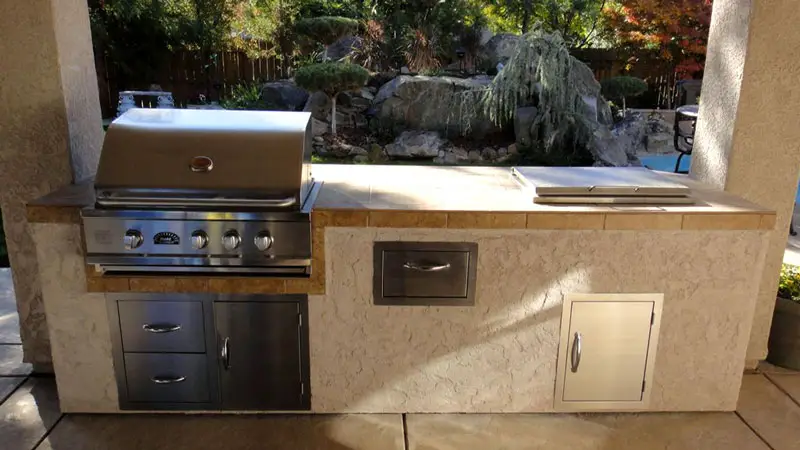
What do you do with an outdoor kitchen in the winter?
In the Central Valley, many people still use their outdoor kitchen in the winter by adding heaters, a fire pit, or an outdoor fireplace… provided they have ample protection overhead to keep you dry.
However, if you are not planning to cook outside during the winter months, you should take steps to winterize your outdoor kitchen. That includes the following tasks:
- Shut off your water line(s) and drain your faucets
- Turn off your gas line
- Clean and polish your stainless steel grill and appliances
- Thoroughly clean your cabinets, countertops, and sink
- Unplug, empty, and clean your refrigerator, freezer, and ice maker
You should always follow the manufacturer’s instructions related to what you have in your particular outdoor kitchen.
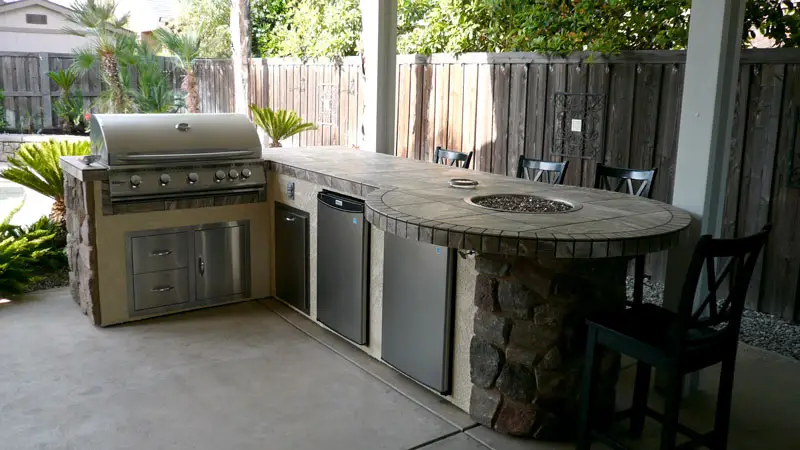
How do you keep outside kitchen pipes from freezing?
The best way to keep outside kitchen pipes from freezing is to shut off the water line(s) supplying water to your outdoor kitchen and then draining out any water left in the pipes by running the faucet until no more water comes out.
With no water in the pipes, there’s nothing to freeze, and your pipes are safe from damage.
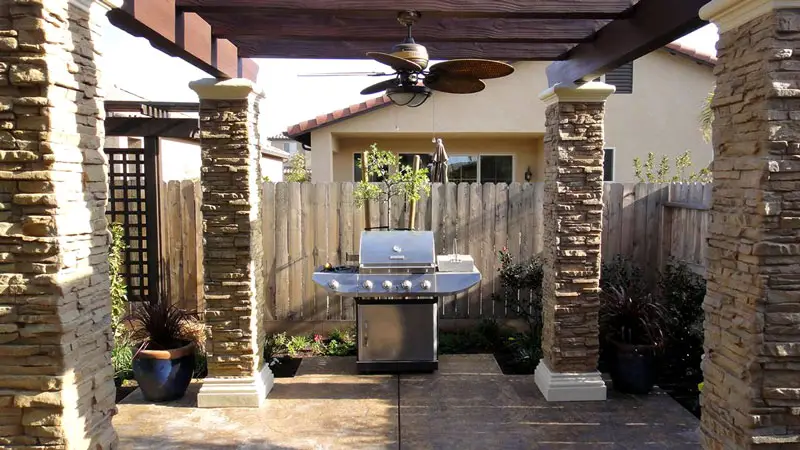
How close to the house can you build an outdoor kitchen?
Most homeowners find it convenient to have their outdoor kitchen as close to the house as possible … specifically, as close to an entrance into the home as possible … for easy access. However, sometimes they want the kitchen to be the focal point of their outdoor space.
The component of your outdoor kitchen plan where placement matters the most is the grill (especially a gas grill) and any other fire-based cooking devices (like a pizza oven). The U.S. Consumer Product Safety Commission recommends using the grill at least 10 feet away from the house. Most manufacturers recommend a minimum of 3 feet.
Some homeowner’s insurance companies also have specifications for how close an outdoor kitchen can be to the home.
All recommendations and specifications for placement of the elements you’re including in your outdoor kitchen need to be carefully considered in the design stage to ensure that you’ll be able to safely use your outdoor kitchen. This is just one of the many reasons that many homeowners rely on outdoor kitchen experts when adding an outdoor kitchen to their home.
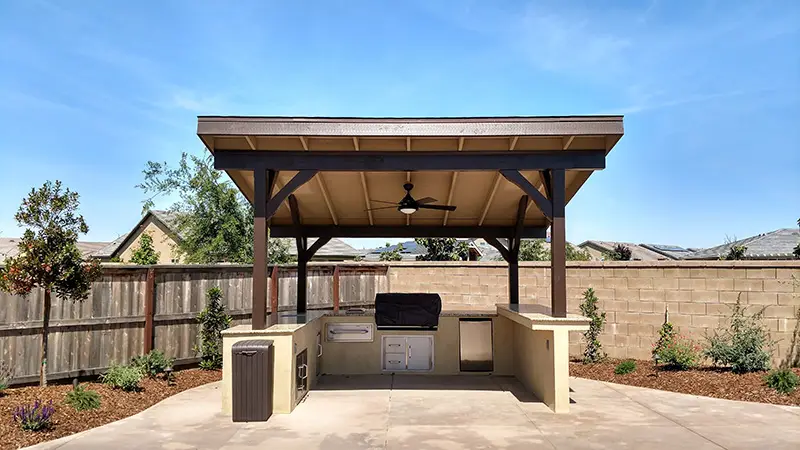
What should I include in my outdoor kitchen?
The options are endless for what to include in an outdoor kitchen. But you should only include the components that you’ll actually use.
For example, an authentic wood-fired pizza oven is a fantastic addition to an outdoor kitchen … if your family makes (or wants to make) pizza at home. If not, you probably shouldn’t include it.
Some popular components to consider including in your outdoor kitchen layout include the following:
-
Grill
- Grill island
- Pizza oven
- Smoker
- Cooktop or side burners
- Griddle
- Oven
- Warming drawers
- Sink
- Garbage disposal
- Dishwasher
- Refrigerator
- Wine refrigerator
- Freezer
- Ice maker
- Countertop prep space
- Seating area
- Bar seating
- Storage drawers and/or outdoor kitchen cabinets
- Lighting
- Ceiling fan(s)
This list is not all-inclusive, and your outdoor kitchen should include whatever you want or need to enjoy cooking and entertaining outdoors. If you can dream it, there’s probably a way to make it happen.
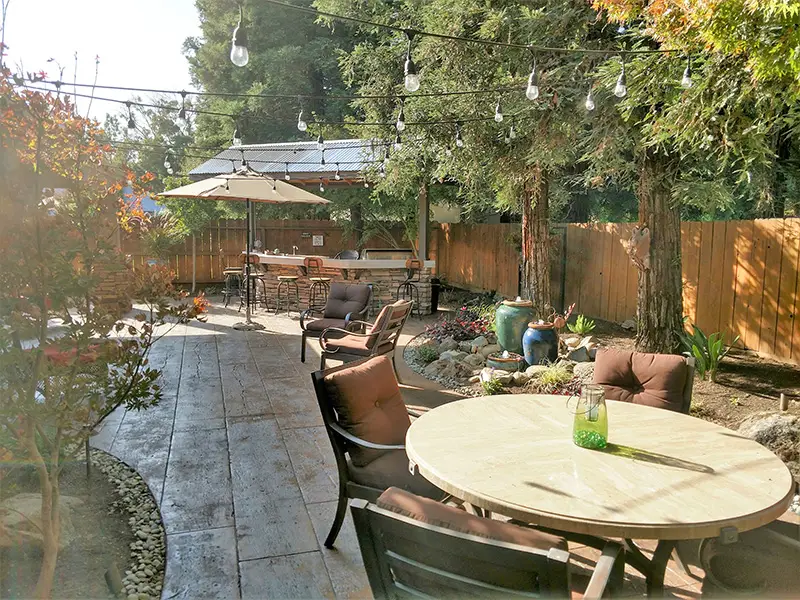
How much space is needed for an outdoor kitchen?
An outdoor kitchen can be as large or small as you want. It really depends on the amenities you want to include and the number of people who will typically be using the space.
Generally speaking, you’ll need a minimum of 10 linear feet of counter/work space for a simple “small” outdoor kitchen. That gives you space for a BBQ, sink, and some countertop work area.
While most outdoor kitchens tend to be in the 100-400 square feet range, yours can be whatever size you want. If you have the space and budget, outdoor kitchens can be as large and elaborate as indoor kitchens, with outdoor kitchen islands, bar seating, additional appliances, storage space, etc.
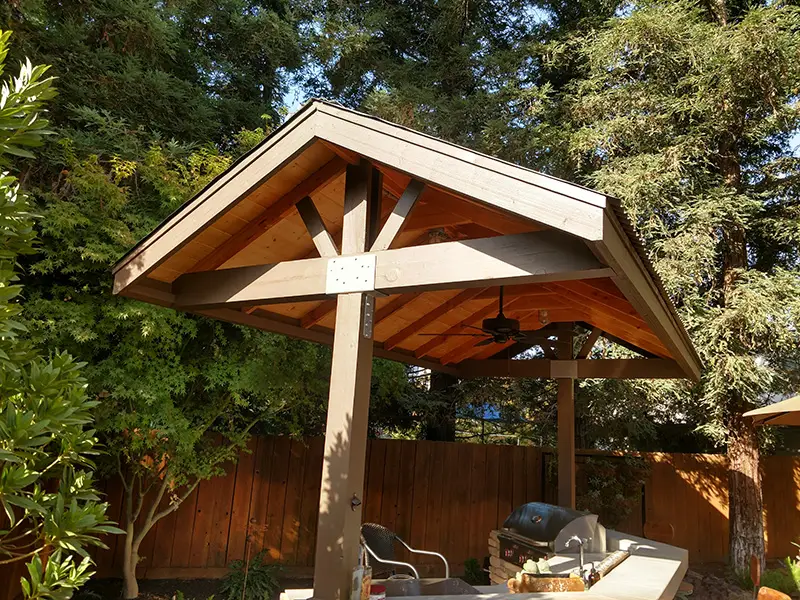
Can you put a dishwasher in an outdoor kitchen?
Yes! You can certainly put a dishwasher in an outdoor kitchen, and it’s a popular option. Many people like the convenience of being able to clean up without having to cart all the dirty dishes inside.
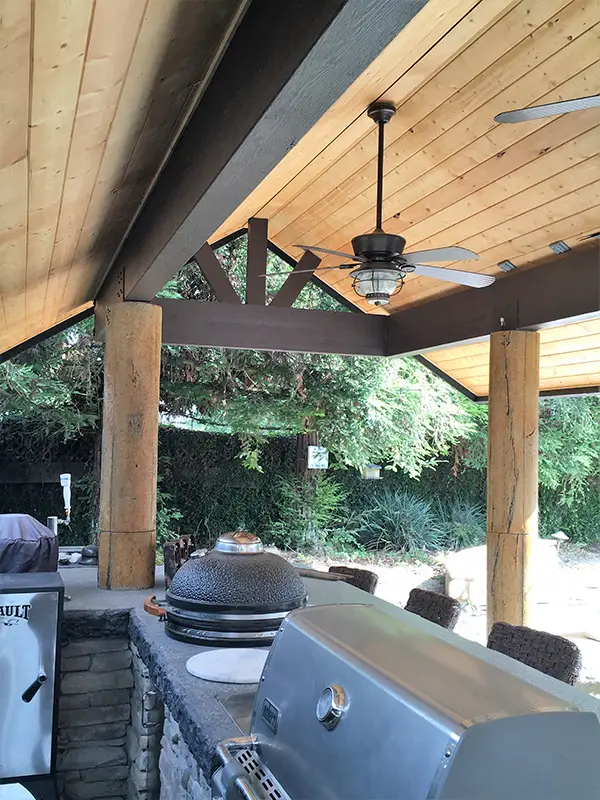
What kind of grill do I need for an outdoor kitchen?
Typically, grills in outdoor kitchens are either propane or gas. However, if you prefer using pellets, charcoal, or even wood … those options can be incorporated into your design ideas.
And while most outdoor kitchens have a built-in grill, along with other appliances of choice, you can use a freestanding grill instead if you have a favorite that you already own (or want to buy).
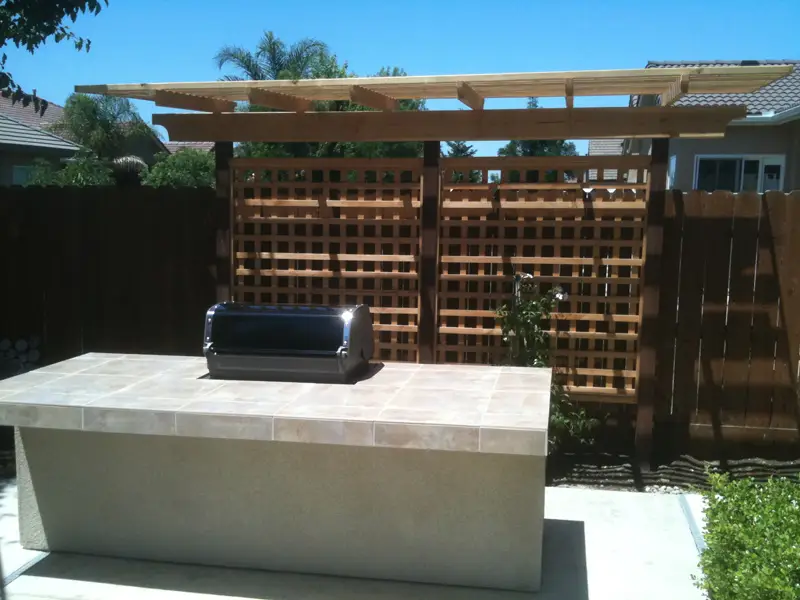
Can you build an outdoor kitchen on top of pavers?
Yes! You can build an outdoor kitchen on top of pavers. When installed properly, pavers give a solid foundation for the construction, and they’re durable enough to withstand the use that the kitchen will get.
The other benefit of using pavers in your outdoor kitchen is the design variety. With the wide selection of pavers available, you can get just the look you want for an outdoor kitchen you’ll love.
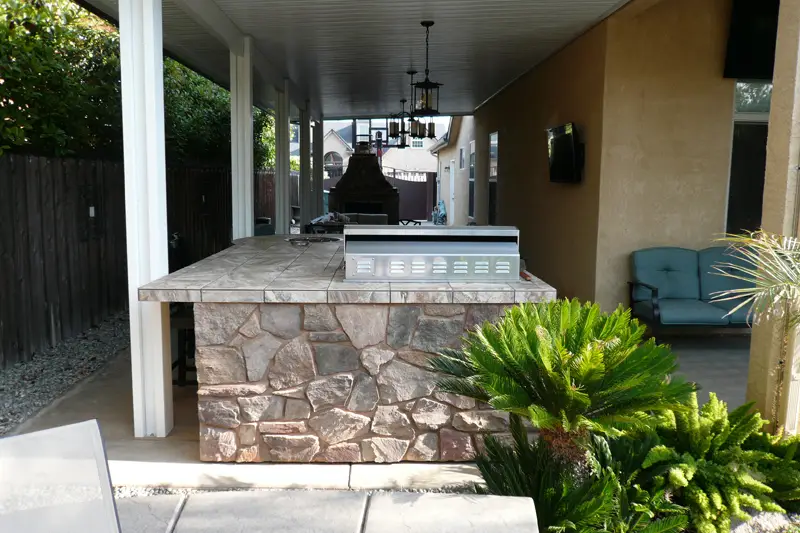
Can you build an outdoor kitchen on a deck?
You can build an outdoor kitchen on a deck as long as it’s constructed properly to accommodate the weight and utility connections (water, gas, and power). The wood used for the decking is another consideration when determining whether or not the deck is suitable for an outdoor kitchen.
Safety is a key factor in any outdoor kitchen, so be sure to consult an expert to determine if your deck can handle an outdoor kitchen.
Why Choose Mike’s Evergreen
Mike’s Evergreen is the right choice for your outdoor kitchen needs because we are the Valley’s premier outdoor living experts. We work hard to understand your goals and provide quality results that will exceed your expectations. We understand that one of your biggest and most important investments is your home or business. Your objectives, lifestyle, personality, as well as the specific needs of your property are carefully considered to reflect a landscape that will provide beauty, function, and value to your home or property. Mike’s Evergreen offers a complete range of landscape services so we can make your yard look the way you intend it to.
Enhance your Landscape with Our Expertise
Construction
Landscape Construction projects are permanent to semi-permanent installations and should be considered an investment in your home.
Outdoor Living
Custom designed outdoor living areas allow you to have a beautiful and functional living space to entertain and enjoy with family and friends.
Custom Concrete
Brighten up your landscape with a custom colored or stamped designed concrete path, driveway or patio.
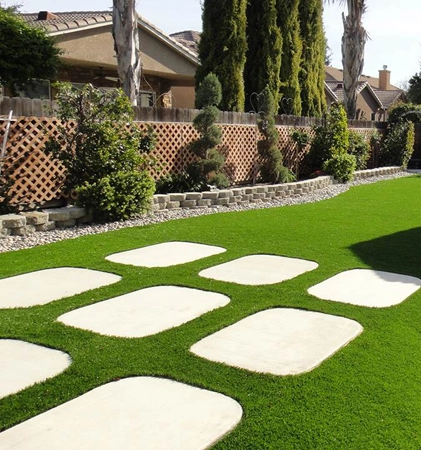
Pavers & Flagstone
Typically installed as an alternative to concrete, pavers and flagstone come in many shapes, sizes and patterns.
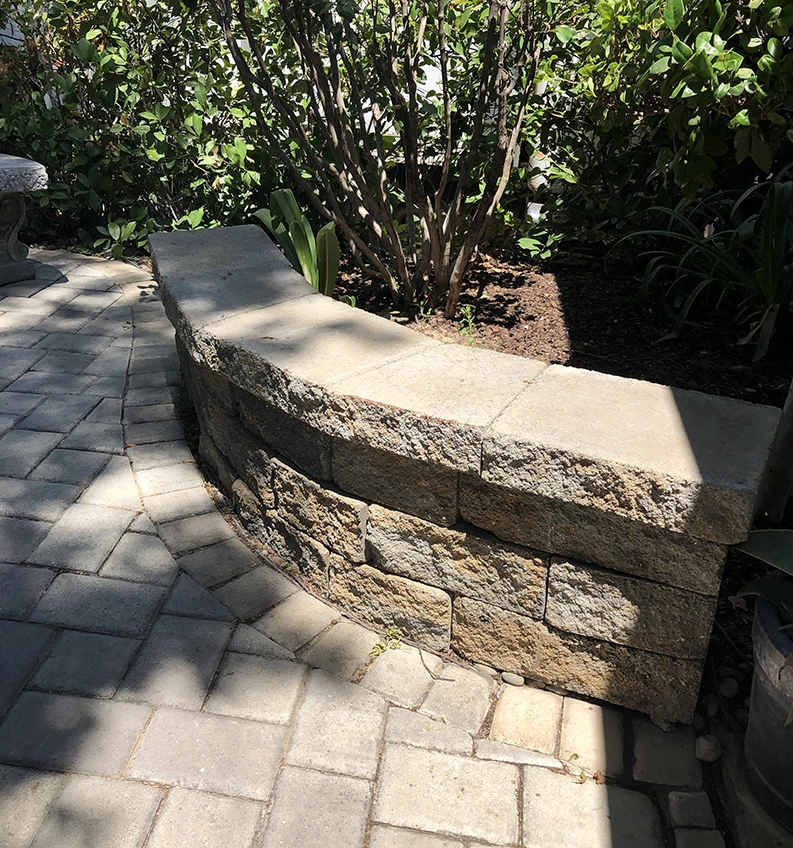
Retaining Walls
Landscape retaining walls are utilized to increase usable space, provide additional elevations, seating, and planting areas.
Fire Pits & Fireplaces
Fire Pits and Fireplaces are both structures that provide a visual focal point while giving off warmth and light.
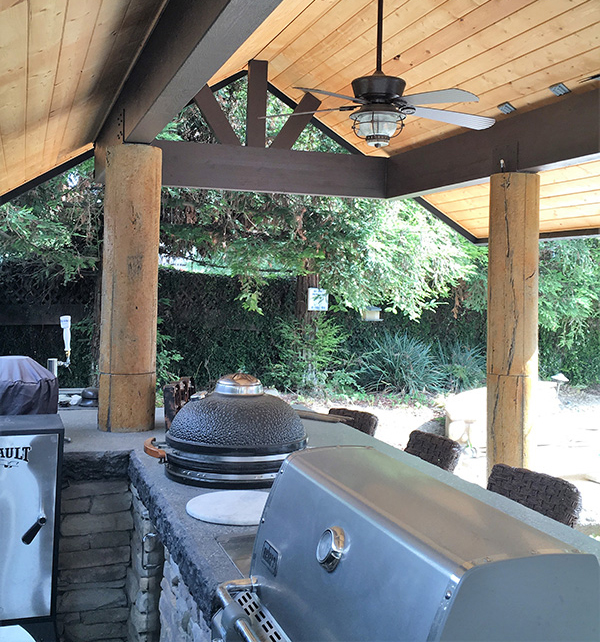
Outdoor Kitchens
Take your entertaining to the next level with the ideal outdoor setting for you and your guests.
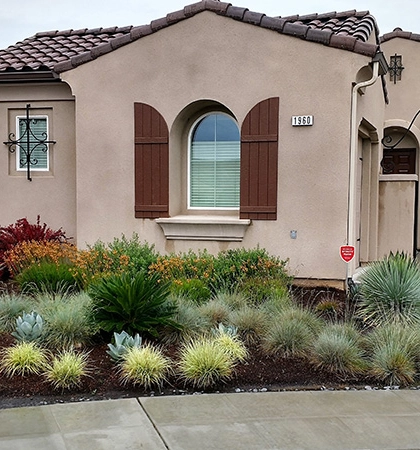
Drought Resistant & Xeriscape
Is your idea of a drought-tolerant landscape rocks and cactus? Think again!
We can design your yard to save water with a drought-tolerant or xeriscape landscape. We can create an entertainment area with hardscape and colorful pots with plants/flowers supplied with drip irrigation. You could have a serene area with a fountain that re-circulates the water. We pick plants that are adapted to our climate and can thrive with low water and low maintenance. Even with our current drought, you don’t have to stop using your front or back yard.
Water Features
Mike’s Evergreen can install a variety of water features for your home. From ponds and waterfalls to fountains and bubbling pots.
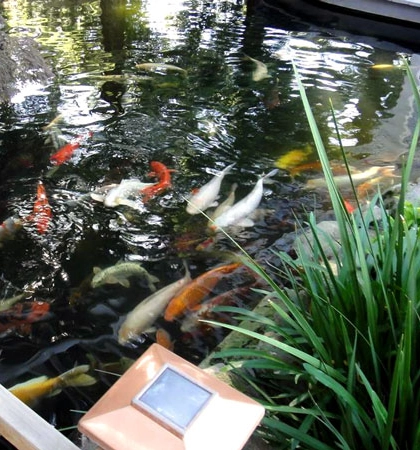
Koi Ponds
Mike’s Evergreen can design the perfect Koi pond for your yard, whether you have a small space or a large space, there is a pond for you.
Sprinkler Repairs
Broken Pipes and Leaks – We’ll fix a geyser or muddy spot in the yard.
Timer/Controller Adjustment – We’ll adjust your timer to keep your yard green and avoid over-watering.
Sprinkler Heads Repaired – We’ll get each sprinkler set just right and replace any broken ones.
Drip Irrigation – We’ll check your entire system to ensure it works properly and fix any issues.
Your Vision Our Design
Your project will seamlessly go from the design stage to completion. 3D design is an effective tool for you because you can see your project before we even break ground. It just makes sense to have an actual Landscape Contractor do the design, as we will also be the builder and are better equipped to understand your budget versus labor and material costs and what is realistic.
Landscaping Tips
Revitalize Your Lawn through Aeration.
By creating hundreds of little holes in your lawn’s surface, allows for rain water and nutrients to more quickly penetrate the surface of the lawn. This also feeds the roots of your plants and grass. By aerating your lawn, you’ll help prevent the soil from becoming compact, which allows the root systems of your lawn to grow deeper. Aeration occurs when you use a tool specifically designed for aerating your lawn. It is a tool with little spikes that puncture your lawn as you roll it across your yard. The little puncture marks provide fresh air to penetrate to the root system of your turf.
Your lawn will stay looking more beautiful and healthy if you aerate it.
How to Prune Rose Bushes
- Use clean, sharp tools.
- Look at the overall plant, but begin pruning from the base of the plant.
- Prune to open the center of the plant to add light and air circulation.
- Make your cuts at a 45-degree angle, about 1/4 inch above a bud that is facing toward the outside of the plant.
- Ensure it is a clean cut (not ragged).
- Remove all broken, dead, dying or diseased wood (any branches that look dry, shriveled or black). Cut until the inside of the cane is white.
- Prune any weak or twiggy branches thinner than a pencil.
- Remove sucker growth below the graft.
- Trim any remaining foliage.
There are certain things a tree owner must know to keep trees healthy and in the very best condition. Here are just a few:
Limit Staking Your Tree
Tree staking is never done with the intention of harming a tree. Staking is usually done with love and with a desire to promote root and trunk growth and protect a young tree from harm.
What some tree planters do not understand is, rather than helping a tree develop root and trunk growth, improper tree staking replaces a supportive trunk and root system with an artificial support that causes the tree to put its resources into growing taller but not growing wider.
Protect a Tree’s CRZ
Before starting a mulching project, become familiar with the critical root zone (CRZ) or tree protection zone. This zone is generally defined as the area under a tree and out to its drip line. Improving conditions in this protection zone will also result in major health benefits to a tree.
Mulch Your Tree
Mulching is the most beneficial thing a home owner can do for the health of a young tree. Mulches are materials placed on the soil surface to improve soil structure, oxygen levels, temperature, and moisture availability.
Fertilize Your Tree
Ideally, growing trees should be fertilized throughout the year. The greatest amounts should be applied during the early spring and summer months. Several light applications a year are preferred as the tree gets older.
Prune Your Tree
Pruning is essential in developing a tree with a strong structure and desirable form.
Storm Proof Your Tree
A tree is never in greater danger than during a storm. That can mean a threat from pounding rain and hail, from the fury of the wind or the scorch of lightning. You may also have to remove a tree that endangers life and property during or after a storm.
Winterize Your Tree
Trees in Fall are beginning their dormant phase. Some trees may seem to be inactive but the fact is they need to be winterized – protected and cared for to remain healthy and free from diseases and insects.
Prepare Your Landscape for Spring
After the last cold snap, it’s time to clean up all the accumulated debris from your lawn. You want to help your landscape get off to a healthy start by doing the following:
- Remove all leaves and other plant debris such as sticks and dead plants.
- Aerate damaged areas by turning over dirt and removing plugs of dirt.
- Mow the lawn about 30 percent shorter than you would normally.
- Apply seed or starter fertilizer according to manufacturer instructions.
- Cover all patches with peat moss or mulch.
- Thoroughly water your lawn and keep it consistently moist for two to four weeks.
- Fertilize again after four weeks.
Freezing temperatures can be damaging to a landscape. There are a few things you can do to help keep your landscape protected, even in harsh winters.
The key is to remove debris, leaves, pine needles and unwanted branches from around your landscape. If these items are not removed, they can contribute to rot and mold along with other lawn diseases. By removing them, you’re leaving plenty of room for new growth that will contribute to a healthy landscape in the spring.
It is also very important to keep your lawn weeded regularly. You can weed by hand or by applying herbicides so that your turf has plenty of room for growth.
Winter is the perfect time to aerate and de-thatch your turf. During summer months, it gets packed down and tangled. Aerating will help open up your turf to fresh air, water and nutrients that are imperative for healthy growth.
Protect your lawn from freeze damage by doing the following before a freeze:
Water Your Lawn
Thoroughly water your landscape plants before a freeze. This can help reduce any change in your plants caused by freeze damage. Cold and dry winds often accompany cold weather, which can dry out plants. By watering your plants, you will help retain moisture. Wetting the foliage of plants before a freeze does not, however, provide any cold protection. A well-watered soil will also absorb more solar radiation than dry soil and will re-radiate the heat during the night.
Move Plants Inside
If possible you’ll want to move all your plants, in containers, inside your home, where the temperatures will stay above freezing. If it’s not possible to bring them inside, try to place them close to the base of your home to help keep them as warm as possible during a freeze. Covering your plants in plastic can also help keep them from getting freeze damage. If you move your plants inside, make sure you give them as much light as possible, so they can continue to grow.
Mulch
Mulch can help protect plants that are in ground. Using dry material like pine or straw will help keep moisture in. You should be aware that mulches will only protect what they cover. Mulch at the base of a bird-of-paradise will help the roots, but will provide no added protection to the leaves. Mulches, then, are best used to protect below-ground parts or crowns or may be used to completely cover low-growing plants to a depth of four inches. Leave cover on no more than three or four days.
Cover
Do your best to cover any outside plants with plastic or cardboard boxes. Styrofoam boxes also help with insulation. You want to cover them the best you can to avoid freeze damage.
Proper Care of plants in the cold winter includes making sure you do a deciduous perennial cut back. This allows the perennials to focus on the growth necessary in early spring to maximize the foliage and blooms throughout the year. Without proper care and attention, perennials will have to fight through the old growth in the spring time. You want to cut them back, so they have plenty of room to flourish. Unfortunately, winter perennial cut back are often overlooked. Make time and effort to cut back your perennials. You’ll be able to see a noticeable difference during their peak season.
There’s no better way to get into the holiday spirit than to decorate your home with beautiful poinsettias. The scientific term for poinsettias is: Euphorbia Pulcherrima. Introduced in the United States by Joel Roberts Poinsett (who fell in love with the plant called flor de noche Buena – while U.S. ambassador to Mexico in 1828 and began growing and giving them out as gifts in his home state of South Carolina), they make up 85% of potted plant sales during the holiday season.
Poinsettias are commercially grown in every state, with California the top producer, and though they come in other colors such as white, pink, orange, pale green and cream, red is the most popular and preferred. They can grow to be several feet in height and bear dark green leaves that measure three to six inches in length. To acquire color, it must be left in the dark for 12 hours at a time; at the same time, the plant needs much light during the day to reach a bright color.
They are a perennial, tropical (non-tolerant to freeze, which means you must bring them in when it gets too cold) shrub that exudes holiday cheer with their vibrant and festive colors. Whether adding to your courtyard design outside or livening up your foyer to greet family, friends and guests inside, poinsettias are perfect for the holiday season.
There are three main benefits for pruning (also known as tree trimming or tree cutting) your trees:
- Personal safety
- Health of the tree
- Tree appearance
It is often recommended for personal and property safety reasons to reduce the risk of falling limbs and branches. In addition it is important to remove branches that may be resting on utility lines or near rooftops.
For the trees overall health, proper tree pruning helps stimulate new growth and the healing of wounds. It is necessary for the continued health of the tree to remove dead, weakened, diseased and insect-infested limbs. It can also encourage greater fruit production.
And finally, it improves the appearance of trees in your landscape. This is not only beneficial for the look of your property, but can also increase the overall value! Limbs too close to rooftops can encourage moss and other fungi to grow and reduce the life of the roof. They can also allow various tree climbing animals’ access to your roof and potentially your home.
Winter Rye grass is an annual grass that lives for one season and dies out. This type of grass is useful for creating a green lawn in the winter by over seeding an existing lawn. The nice thing about Rye Grass is that it can be mixed with other seed types such as Bermuda for winter hydro seeding. The Rye will come up immediately while the warm season seed remains dormant until spring. By the time the Rye Grass dies out, the warm season grass will be well established, ideally leaving your lawn looking green year around.
Rye grass is also a great choice to help with erosion control because it establishes itself quickly. Although it’s annual, it can reseed itself naturally to produce new turf each fall, if it is well maintained. It usually takes about 3 weeks for winter rye grass to establish itself.
Mulching can be one of the most beneficial things you can do for your soil and your plants. If you have not considered mulching your garden in the past, you may want to reconsider.
The main reason for mulch is to retain moisture in the soil. A three inch layer of mulch will reduce evaporation and lessen your watering time. Mulch protects soil from baking and drying out by altering the soil temperature and serving as an insulator to accommodate the surface needs in both the summer and winter seasons. Mulch also prevents soil crusting by allowing water to penetrate into the soil for absorption and movement. Consistent moisture fosters healthy plant growth.
Another benefit of mulch is weed reduction. A layer of mulch will help prevent the germination of many weed seeds, reducing the need for cultivation or the use of herbicides. Weed seedlings will smother before they are tall enough to peek through the mulch. Weeds use up water and nutrients intended for your plants. A weed free garden is lush with the proper plants. If weeds are allowed to grow, they will choke out what you have spent so much time and energy designing and planting.
While there are many types of mulch, organic mulches such as wood chips, grass clippings or other locally available materials help improve the soil by adding organic matter as they decompose. They also may encourage the growth of worms and other beneficial soil organisms that can help improve soil structure and the availability of nutrients for plants.
Mulches can also be used to enhance the look of your property. Many bark mulches provide uniformly rich brown color that contrasts with the plants. The mulch helps keep plants clean by reducing the splash of soil onto leaves during rainstorms, and helps infiltration of the rainfall into the garden.
In summary, the main reasons to use mulch are:
- Helps maintain even soil temperature in the roots by keeping them cool in the summer and warm in the winter.
- Promotes plant growth.
- Controls weeds.
- Conserves soil moisture, meaning you use less water.
- Improves soil structure and quality over the root area.
- Protects from mechanical damage (Mowers, string trimmers, etc.)
- Helps beautify your plantings.

